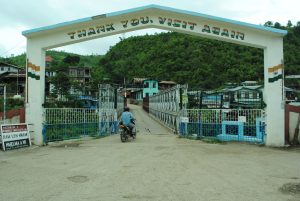The Indian government has firmed up plans to terminate the Free Movement Regime (FMR), which allows residents on either side of the India-Myanmar border to visit each other’s territory up to a distance of 16 km (10 miles) without a visa.
Government sources cited by the media said that they also plan to equip the border with an “advanced smart fencing system” within four-and-half years. A smart fence has already been installed at some stretches along the India-Bangladesh border.
The rationale of the government’s decision stems from cross-border criminal activities such as the influx of illegal immigrants, and smuggling of drugs, gold, and exotic animals. Anti-India separatist groups that have camps and training facilities in Myanmar have also taken advantage of the FMR to carry out attacks in the northeastern Indian states that share borders with Myanmar.
Recently, the Manipur government made a fervent plea to the central government to put an end to the FMR along the India-Myanmar border. The state government is concerned over illegal immigration from Myanmar and has alleged that a section among the illegal immigrants is engaged in poppy cultivation. The state government also implicated migrants from Myanmar in the recent riots in Manipur that were triggered in May last year.
The Manipur government wants the entire 398-kilometer (247-mile) border between the state and Myanmar fenced, of which only around 10 km has been fenced so far. The fencing project was suspended following objections raised by civil society groups, who claimed that Manipur would end up ceding territory to Myanmar if the fence was erected.
The 1,643-km India-Myanmar border runs through the states of Arunachal Pradesh, Nagaland, and Mizoram besides Manipur. Communities residing along the border share ethnic ties and a common ancestry that sustain the social and economic linkages.
The FMR, which was introduced in 1970, is a mutually agreed arrangement between India and Myanmar that allows communities living along the border to travel to the other country for a period of up to two weeks. They require a border pass with one-year validity.
In reality, the norms are not always followed by the residents living along the border in the two countries.
During assignments along the border districts over the past several years, I came across many cases of citizens from Myanmar who had taken up menial jobs and students enrolled in colleges in India owing to the lack of facilities in Myanmar.
There are 390 villages in the Naga-inhabited region in Myanmar’s Sagaing Region, contiguous to the Indian states of Nagaland and Arunachal Pradesh. However, the Myanmar government has recognized only 266 villages. The villages that are not recognized have been deprived of schools and health care facilities. Locals in Nagaland’s Phek district have been quoted as saying that residents across the border preferred to visit the Indian side for education, trade, and medical facilities. An estimated 5,000-6,000 Nagas from Myanmar have been living in Nagaland since the early 1970s and they have been assisted by their relatives, village communities, and civil society groups.
The military coup in Myanmar early in 2021 has made the situation worse, with thousands of refugees taking sanctuary in the Indian border states, with the maximum number coming to Mizoram. Most of their villages were raided, burnt, or bombed by the junta in retaliation to resistance groups fighting the military regime.
While the refugees have been assisted by the local communities in Mizoram and Nagaland, the Manipur government and civil society groups in the state’s Imphal valley have registered their protest against the continuing influx of Myanmar’s citizens. However, implementation of the termination of the FMR regime along the India-Myanmar border is unlikely to be easy for Manipur. Local groups and political parties have already started opposing the government’s decision.
The Naga Students Federation (NSF) in Nagaland has urged the central government to review its decision and engage in a “meaningful dialogue” with the Naga community for a solution that respects “our historical rights and aspirations.” The federation has made a case for an inclusive resolution that respects the historical realities and aspirations of the Naga people.
Two days after media reports announced the central government’s decision to abolish the FMR, Mizoram’s recently elected Chief Minister Lalduhoma said that fencing the border is “unacceptable.” He expressed his opposition to Prime Minister Narendra Modi in a meeting held earlier this month in New Delhi. Echoing the chief minister was the Young Mizo Association, the largest civil society group in Mizoram, which has been assisting refugees from Myanmar with the help of other local organizations.
It remains to be seen how the Indian government will implement the new policy across the four states in the country’s northeastern region. It has not yet spelled out details of the plan to put an end to the FMR.

































